
Veterans trip autumn 2022
First a few enthusiastic reactions from my fellow travelers.
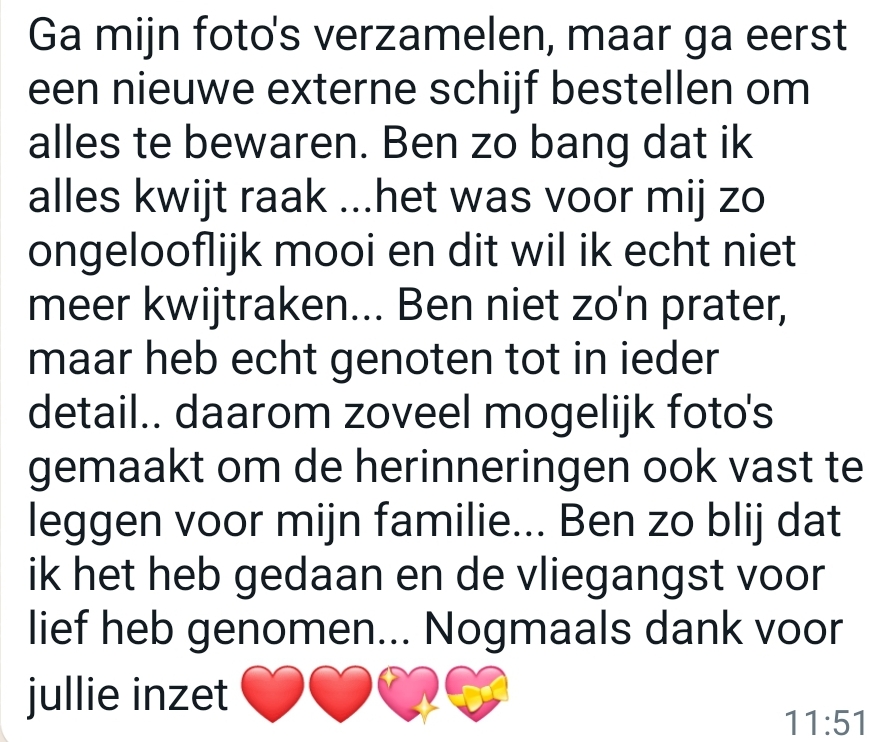
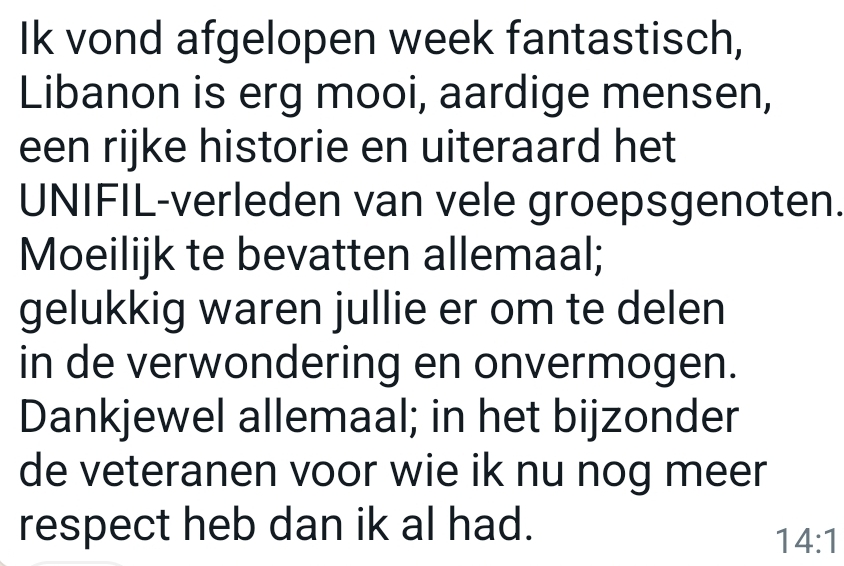
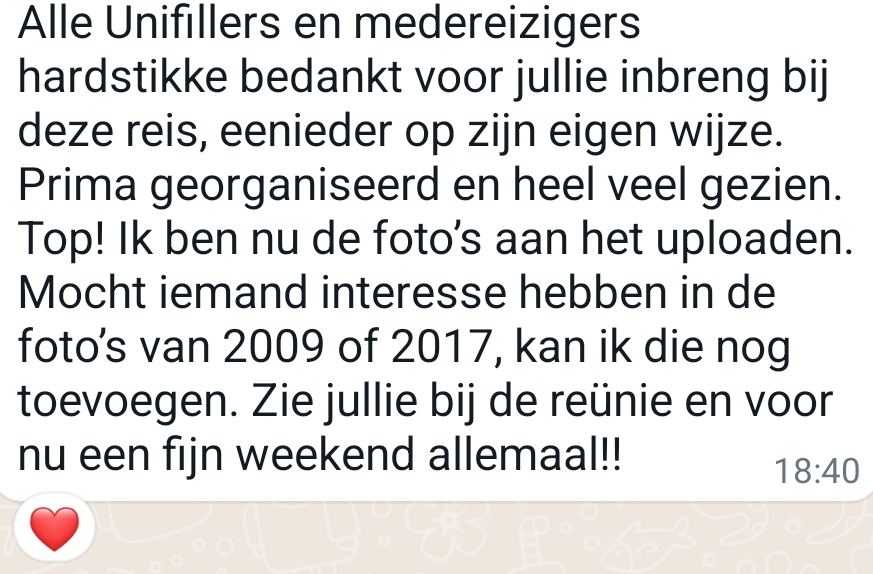
Below is a report of our trip to Lebanon in October 2022.
The trip is organized by Jeannet and Bert Kleine Schaars, both are involved in the Veterans For Lebanon foundation.
On October 7th, after a long preparation, we finally depart from Schiphol for our trip to Lebanon which will lead us past a number of tourist attractions, but most importantly brings us back to the UNIFIL area where we as veterans have spent our service time.
The tour group consists of 12 UNIFIL veterans some accompanied by partners, son or daughter. In addition to this company, there is also a member of the organization Veterans for Lebanon and two journalists from RTV Oost (director Teun and cameraman Marcus). RTV Oost will join us to record this trip for broadcast.
Day 1, Friday 7 October
We get up early to finally leave at 8 o'clock in the direction of Schiphol.
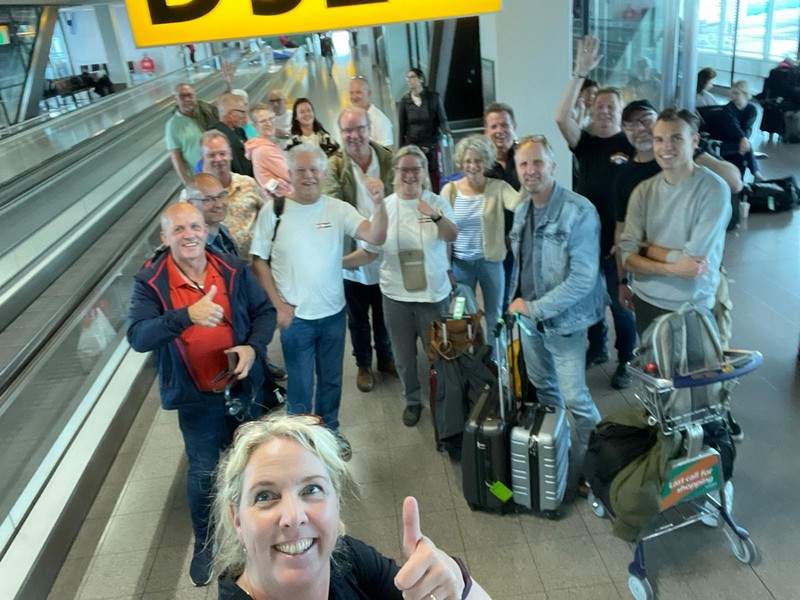
The tour group leaves for Lebanon.
At long-term parking we meet Marcus and Teun from RTV Oost. Siem gives us the final instructions on how and where to check in.
After a short interview session with Marcus and Teun we can board the plane for our rrequirement.
The flight goes well and at 20 hours Lebanese time we arrive in Beirut. After the usual customs duties, we are finally in Lebanon.
In the arrivals hall we meet Georges our guide (an archaeologist with extensive knowledge of land and history) and Hafif our driver.
When we leave the hall I walk up to Teun to tell something about my first impressions.
It is difficult to spontaneously tell something in front of the camera, but it goes well. We have to get used to the presence of the camera.
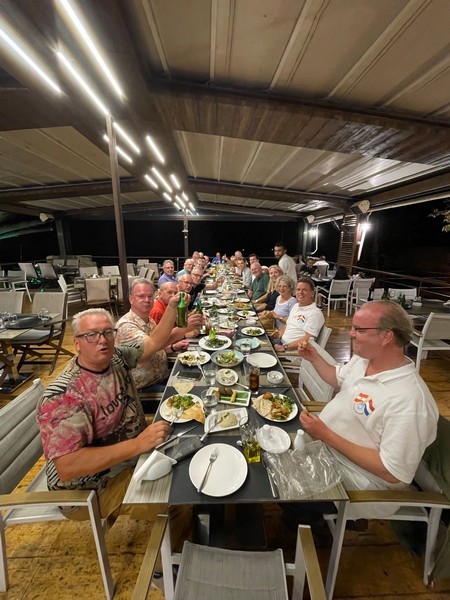
After a bus trip of almost an hour we arrive in Byblos at the restaurant for a fantastic Lebanese meal. A very rich dis of which all dishes are delicious. Marty, Yeb-Jan and I drink a delicious red Lebanese wine, the rest of the group goes to the beer. After this delicious welcome we go to our hotel satisfied for a well-deserved sleep to be at breakfast the next morning at 8 o'clock.
Day 2, Saturday, October 8
After breakfast, the bus leaves for an exchange office where Marty and the others exchange their dollars for Lebanese pounds. There is sky-high inflation so that everyone leaves the office with several million pounds.
Yep-Jan and I meanwhile get into a conversation with a Lebanese who offers us a cup of Lebanese coffee. In our best French we are talking and he tells us about his stay in France and other parts of Europe. We tell about the purpose of our trip, visit to historical places in Lebanon and visit to UNIFIL area in Southern Lebanon. After changing, our bus leaves on its way to the first attraction. During the ride we pay the travel sum in cash to guide Georges.
Everyone is happy that we can transfer this substantial amount in euros and that the journey can continue safely.
The first attraction is an ancient Roman bridge located on an important road in Lebanese history dating back to the time of pharaoh Ramses 2 of Egypt (>3000 years ago). Ramses 2 and afterwards several generals fought here and then left a memorial.
© Marcus Ganzevles RTV-Oost - Romeinse brug in Nahr al-Kalb
The next stop is at the Caves of Jeita, an immense cave complex that has formed over millions of years. We admire the stalactites and stalagmites and make a small boat trip on a subterranean river. At the end of this tour, Bert introduces the 11-hour, a drink and a chat to reflect on something that keeps the speaker or us busy that day. Bert mentions the death of a Unifil veteran who, among other things, has worked for the care of Moluccan graves. After the morning program there is a lunch in Jounieh, after which we leave by cable car to Harisa, a place where Maria is venerated. Many believing Lebanese, not just Christians, see this as a place of pilgrimage. After this visit we return to our hotel in Byblos and continue directly to the souk and the crusader castle at the harbor. Everyone can just capture the sunset at the harbour. At 9 pm we go to the restaurant for another great meal. Lebanese dishes are tasty and not too heavy. But the dis is covered a little too richly. 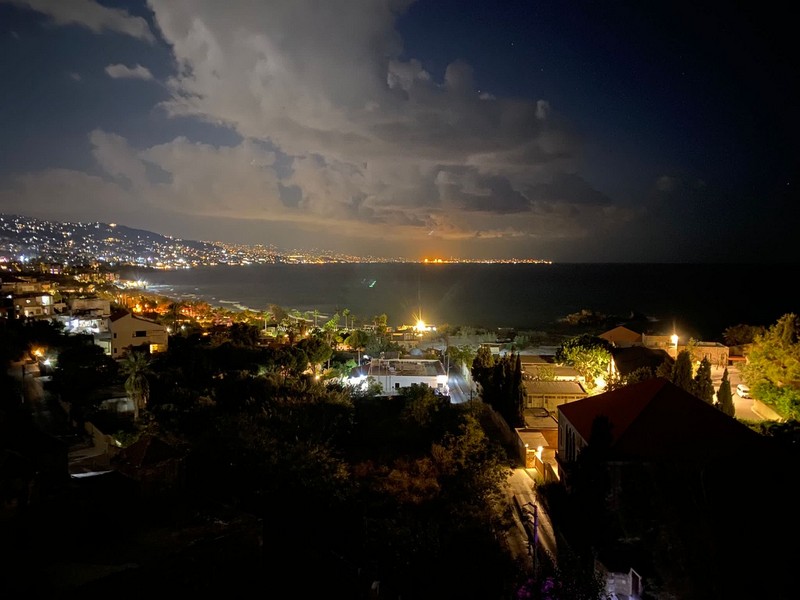
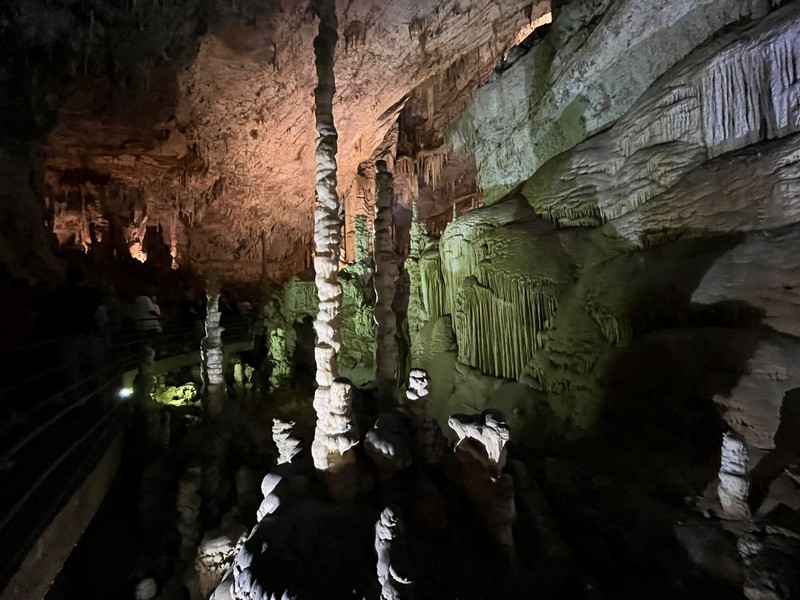 Beirut at night. Caves at Jeita.
Beirut at night. Caves at Jeita.
Day 3, Sunday 9 October
At 7:30 we leave our hotel in Byblos.
Our first stop is the port of Beirut where August 2020 was the big blast. Not much has happened to the area since then, no signs of cleanup or recovery.
For example, a ship is still lying on its side in the water. We take plenty of time to view and photograph the damage.
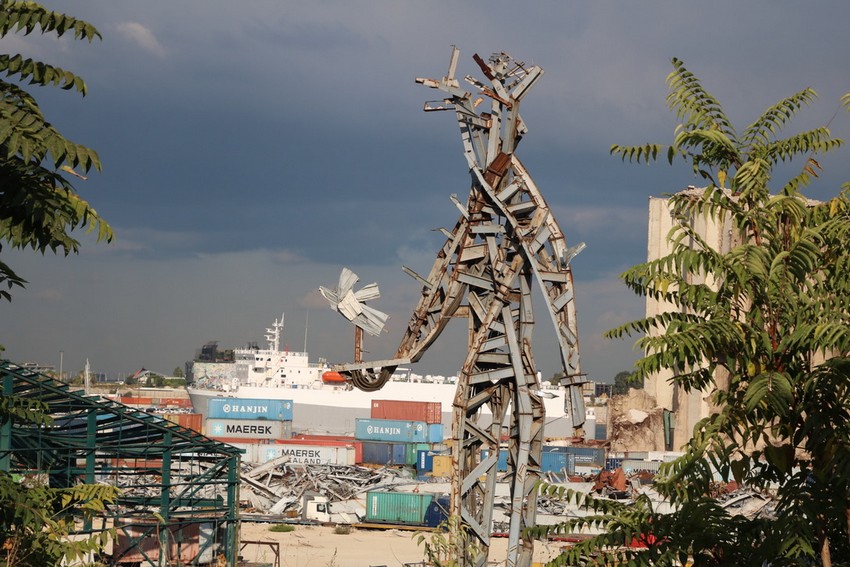
Artwork at the ruins of the port of Beirut.
After leaving this disaster site we arrive on the route from Beirut towards Damascus that will take us to Baalbek. On the way there is a short stop at "Sea Sweet" shop where we can buy typical Lebanese sweet treats. Very sweet and rather powerful.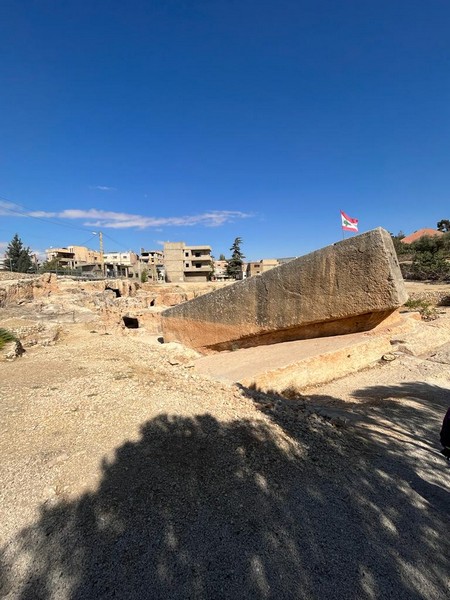
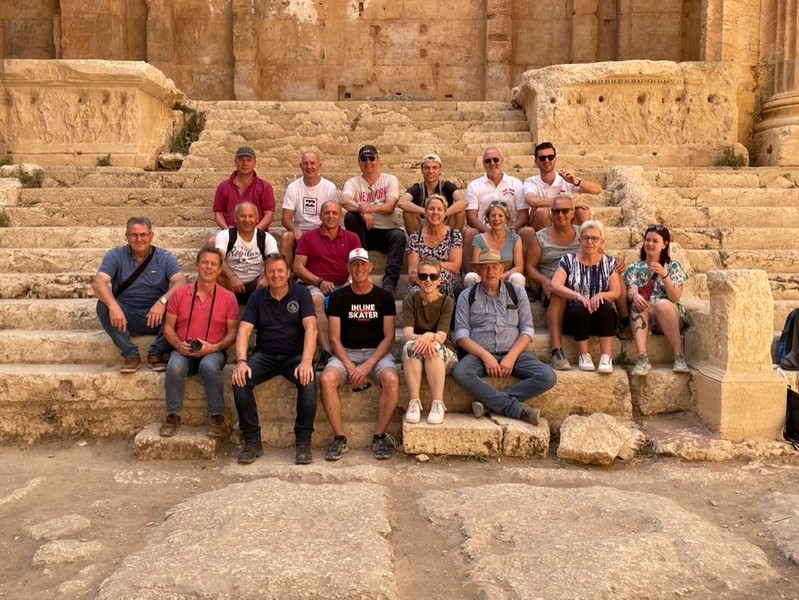 Excavation of a megalith at Baalbek. Travelling party in temple complex of Baalbek.
Excavation of a megalith at Baalbek. Travelling party in temple complex of Baalbek.
We continue our journey towards Baalbek. What strikes us during the last part of the trip are the larger and smaller pieces of agricultural land between the houses, many car wrecking shops and the refugee camps for Syrian refugees.
We arrive in Baalbek, where we admire the massive stones that should form part of the foundation for the various temples in Baalbek. This temple complex is a marvel of engineering and inventiveness in ancient times.
These massive stones, weighing from 1200 tons to more than 1600 tons are known as the megalith mystery of Baalbek. The big question is how the stones were transported and how exactly they were placed against each other. One of the stones has the name Ḥajar el-Ḥ ible, stone of the pregnant woman. Touch by a woman would promote her fertility.
A short distance from the quarry is the temple complex of Baalbek. The temples were built by the Romans on foundations of Phoenician temples. In particular, the temple of Bacchus is in very good condition and appears to be the largest Roman temple that can still be admired in this state.
Poignant is the poverty that we see in the vicinity of the complex. An 11-year-old boy, a Syrian refugee from one of the camps nearby, is trying to sell us socks.
He has to sell socks for 100,000 Lebanese pounds (converted about $2.50) in one day. One of us gives him this amount. Because he cannot calculate, he asks about the value of the gift. After explanation, the realization slowly comes that he has completed his day job and he says goodbye to us with long-term waving.
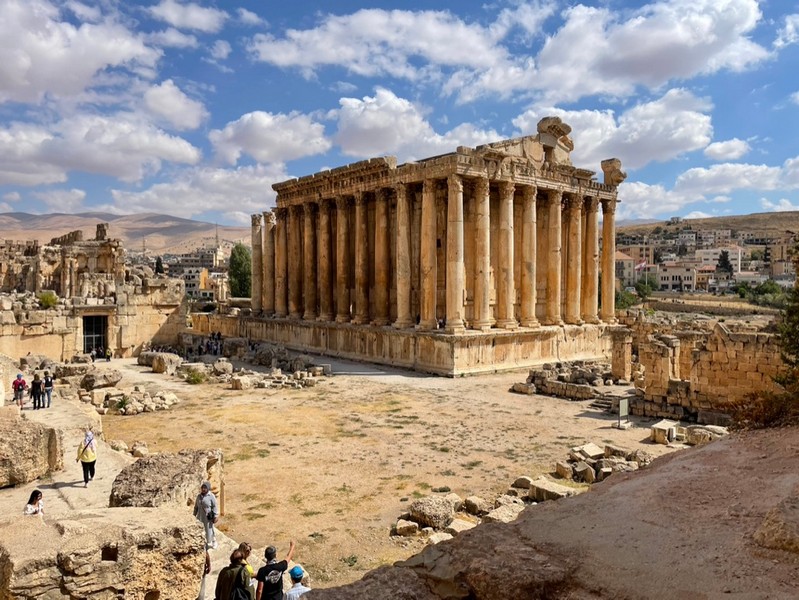 Temple of Bacchus in Baalbek.
Temple of Bacchus in Baalbek.
The next place we visit is Zahle where we climb the tower built in honor of the Blessed Virgin Mary.
We continue our journey to Tyre to hotel Platinum.
Day 4, Monday, October 10
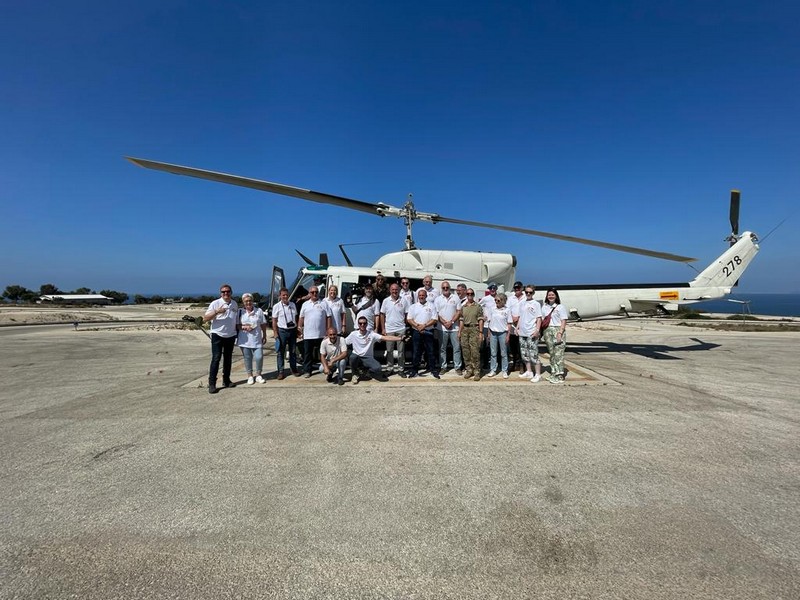 Visit to Italair.
Visit to Italair.
First day in the UNIFIL area in Southern Lebanon. We are received by Suzanne and Corine, two Dutch officers working in this area for UNIFIL and the UNTSO observation team, at the UNIFIL headquarters in Naqoura. They will receive an extensive briefing on the current UNIFIL mandate.
Just a funny moment, during a serious attachment.
In front of the monument at the headquarters, we pay tribute to the soldiers who lost their lives in the service of UNIFIL.
We have lunch at the UNIFIL headquarters and afterwards visit the helicopters of Italair, one of the many shops with UNIFIL paraphernalia and leave for the area of the Charlie company. Our first stop is at post 7-17, Charlies Angels, near Al Mansouri. The post was still there, but there is a fence around it and is therefore impossible to
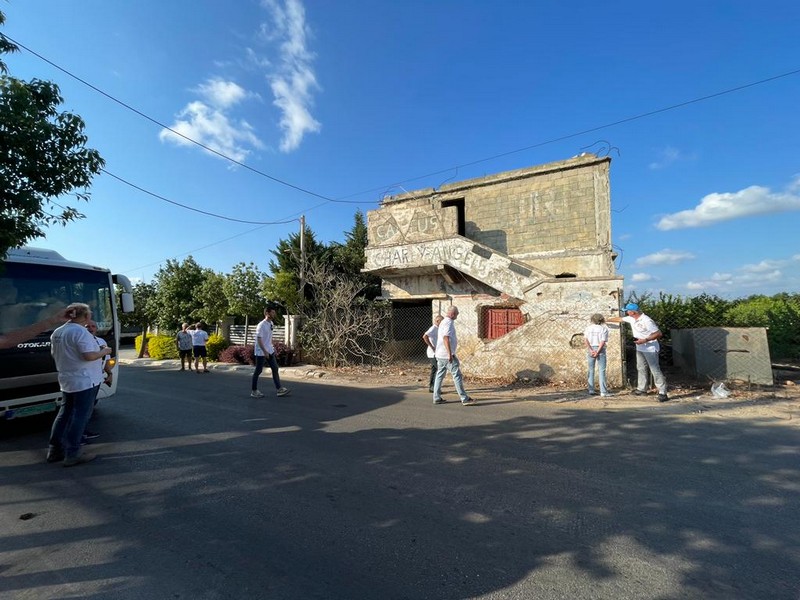 Post 7-17 at Al Mansouri.
Post 7-17 at Al Mansouri.
The road continues via Al Mansouri towards the later headquarters of Dutch Infcoy, post 7-4, in Majdal Zun. Forty years ago this was a road over open area with some buildings scattered around.
Now everything is built full along the entire road. A view of the surroundings as we had it is no longer there. Arriving in Majdal Zun there is vaguely still something to recognize from the old entrance of the post.
On the site, the old roll call place can be recognized, but everything else has changed beyond recognition.
In my time (1984) I had taken a panoramic photo from the roof of one of the houses on our post. Marty, my wife, hung this picture in the house for years and then kept it in a closet.
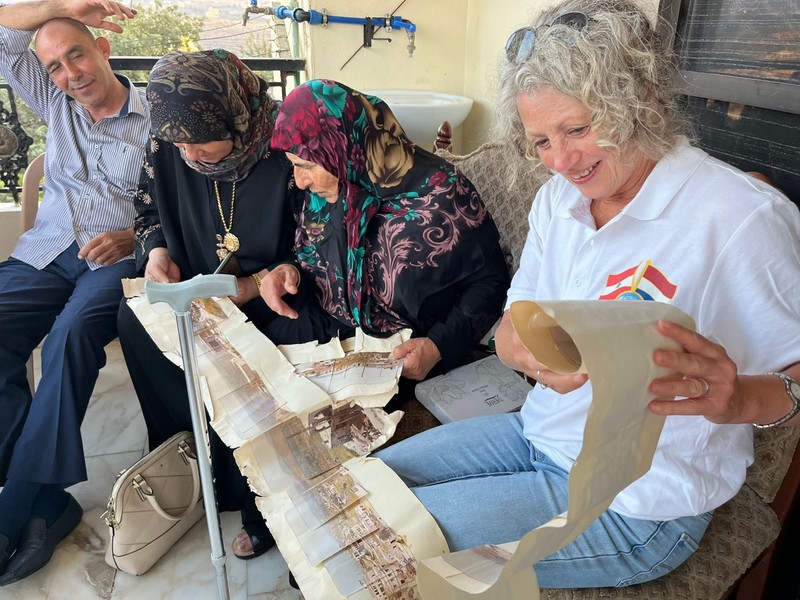
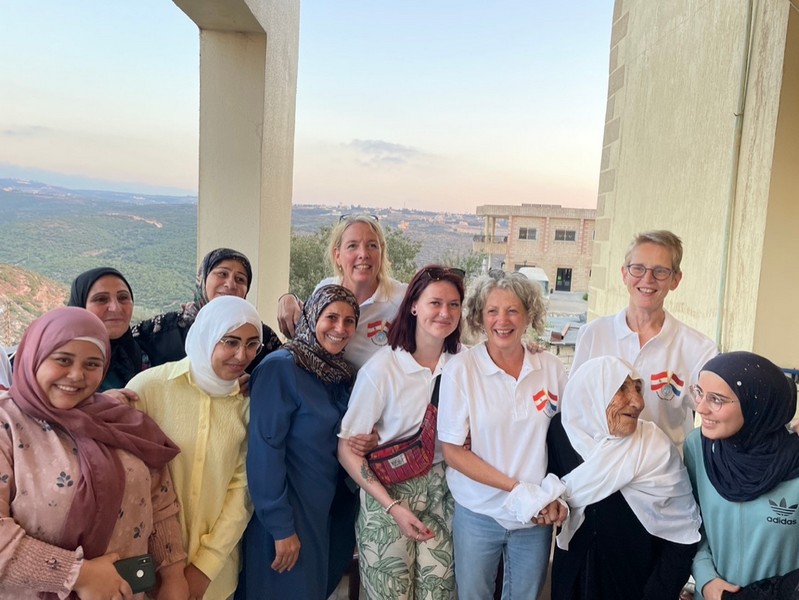 Panoramic photo of Majdel Zun from 1984 is viewed. Reception at the headteacher of Majdel Zun.
Panoramic photo of Majdel Zun from 1984 is viewed. Reception at the headteacher of Majdel Zun.
We had taken this panorama with us and now we could compare the current situation with almost 40 years ago. Villagers came to view the photos and commented on the photo and what had changed, which faces they still recognized. The house opposite the post turned out to still exist.
The distant view to the other side of the wadi had changed but the villagers present helped us to interpret the images. Despite all the changes, there is still a feast of recognition. After a walk through this part of the village we are invited by the headteacher, then 10 years old, to his house. This house was also in the picture I had taken almost 40 years ago.
On the balcony we are welcomed with chai and Lebanese coffee. The whole family is mobilized, up to grandma in her nineties.
Day 5, Tuesday 11 October
At 9 o'clock we leave our hotel and head towards Qana where the headquarters of the Fiji battalion is. In Qana we visit the cave with references to Qana's wedding and where Jesus is said to have turned water into wine.
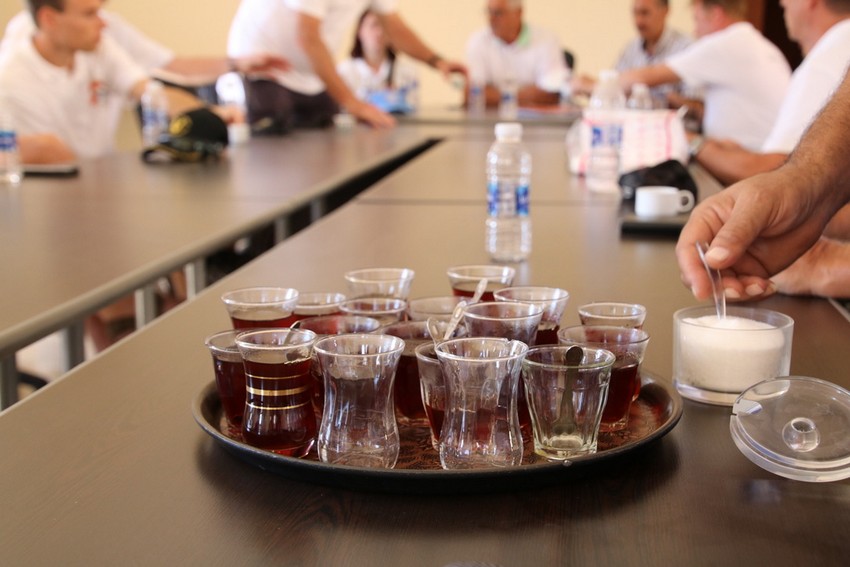
Chai with the mayor of Yatar.
As is often the case here, the question of whether this is the original Qana.
The journey continues towards Yatar to post 7-11. Accompanied by the Lebanese secret service we walk to the post and have a nice view over the surrounding country. Dirk and Yeb-Jan recognize their old post and are also invited together to look inside the old post.
Dirk experiences the visit as a homecoming.
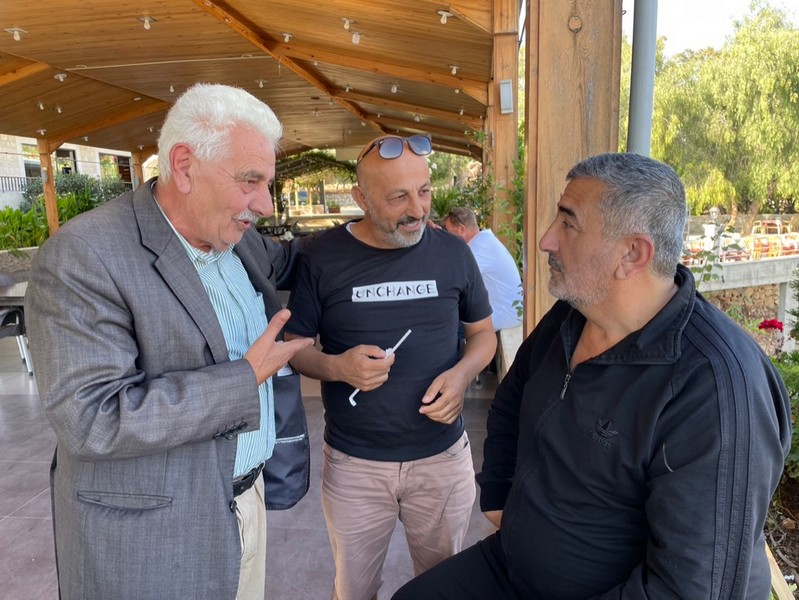
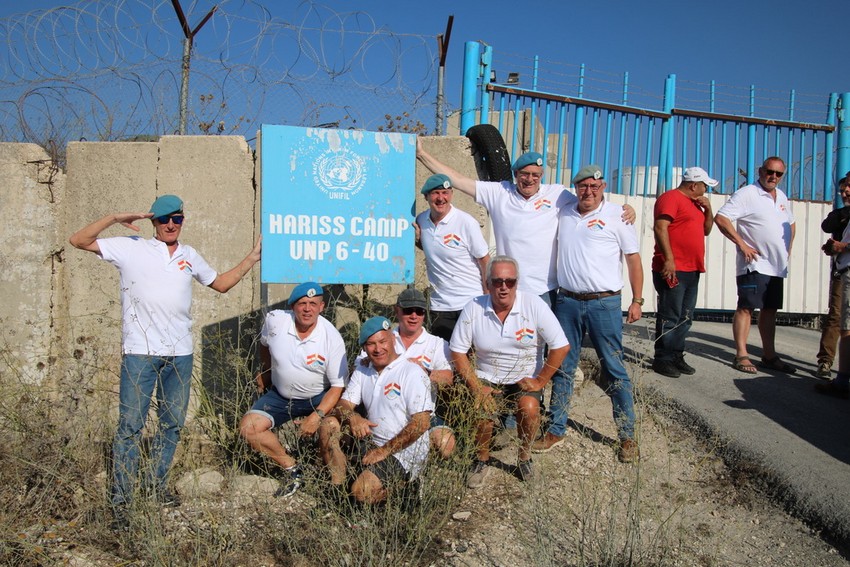 Old acquaintances from the Lebanon era: Ali, Speedy and Wafik. Veterans at their old post 7-16
Old acquaintances from the Lebanon era: Ali, Speedy and Wafik. Veterans at their old post 7-16
Taking pictures and filming is forbidden by the secret service, but an exception is made for Dirk and Yeb-Jan if they are in the old post.
Before continuing to Haris, there is first a visit to the mayor of Yatar for chai and a speech about the current situation in this region and in Lebanon.
In Haris we pass speedy gas station (in Unifil time: "I sell everything and if I don't have it I order it"), a well-known name among all veterans.
Speedy enters the bus and greets us in perfect Dutch. Everything he has learned from 5-6 years of contact with Dutch Unifillers comes out, such as "hello stupid turks", "goat"
We have lunch in Tibnine where some other old acquaintances pass by, such as Ali (Ali's hamburger and pizza) and our interpreter Wafik Dakik. I was particularly looking forward
to the meeting with Wafik.
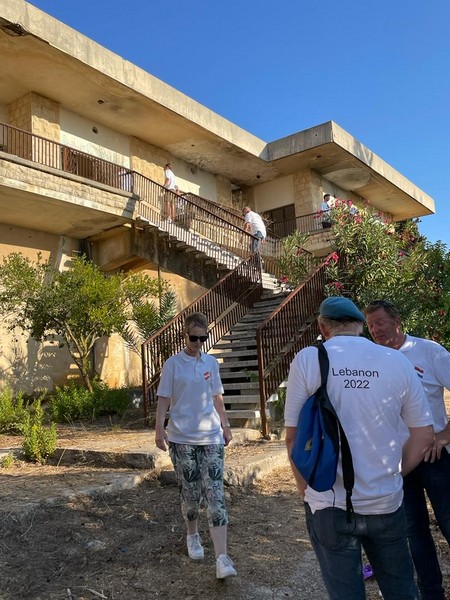 Old HQ of Dutchbatt in Haris
Old HQ of Dutchbatt in Haris
For everyone it is an emotional reunion.
After lunch we visit Al Yatun, post 7-16, initially housing the Delta-cie, later the care clinic. A large part of the veterans who travelled with them spent the UNIFIL time on 7-16. Apart from some remains of the original post, there was not much left of the old farm. Otto wanted to take some pieces of stone with a little blue paint as a memory. Everyone wanted to contribute to this so that Otto left the site only kilos heavier. A visit to the new UNIFIL post of the Malaysians was not in it.
From Al Yatun we walk towards the old headquarters of Dutchbatt in Haris. After the departure of the Dutch in 1983, nothing happened to this headquarters, a luxurious villa with a beautiful view of the town of Haris. We look around the grounds and get a good impression of how the staff there has done its job.
By bus we drive along the old BHP, via old Haris towards the place where soldier Kees van Rijn, on 21-10-1979 had died in a car accident. On the way to our hotel in Tyre there is a short stop at the speedy petrol station.
Day 6, Wednesday 12 October
The day starts quietly, our visit to the Hezbollah museum has been cancelled, the program was a bit too full.
Around 11 o'clock we leave for the old crusader castle Beaufort.
Beaufort Castle is located at a lonely altitude (780 m above sea level) in the middle of the Lebanese landscape. In clear weather there is a phenomenal view up to 70 km away.
The construction of this castle at this height is a unique achievement of the Crusaders.
After visiting the castle we go to lunch in the Phoenician restaurant where the son of our bus driver works. It is a restaurant with a modern entourage and again a good full Lebanese lunch.
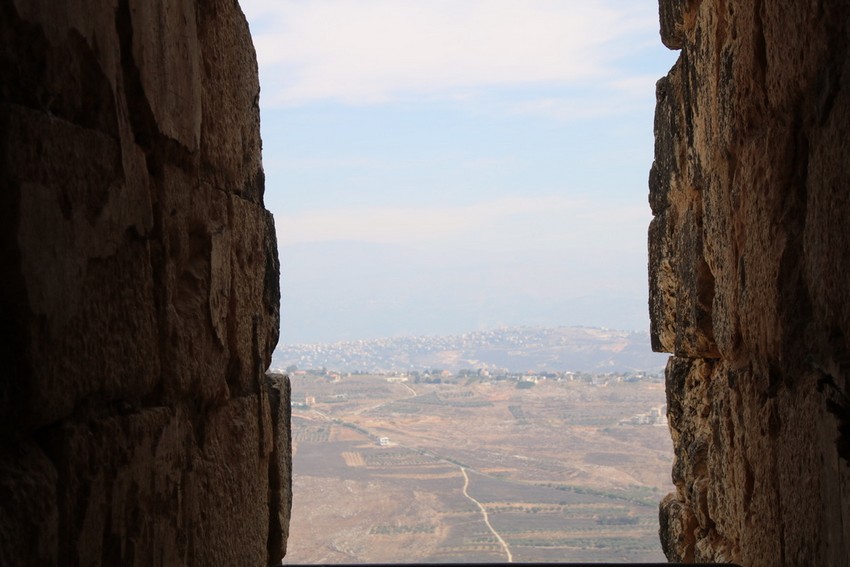 View from Beaufort Castle
View from Beaufort Castle
At our farewell, the entire staff will take a picture with us.
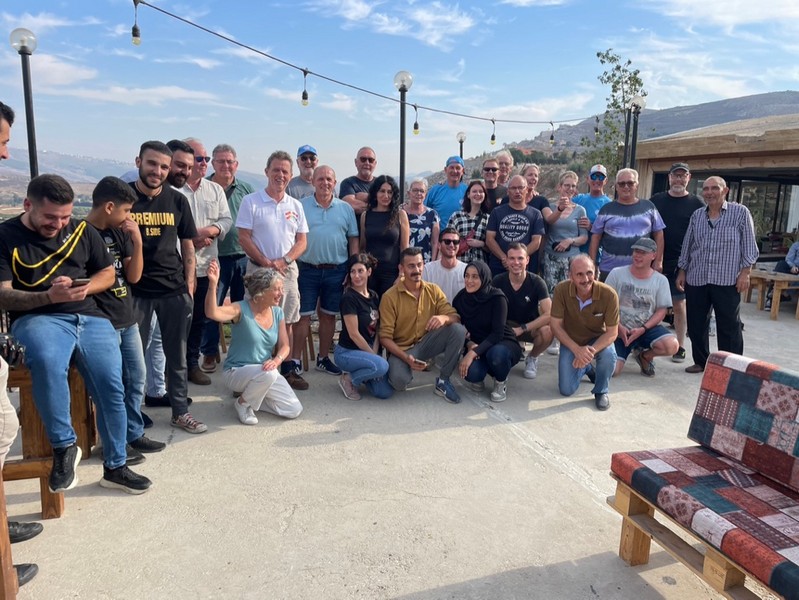 The travelling party and full personnel of Phoenician.
The travelling party and full personnel of Phoenician.
On the return trip we drive past the town of Odaisseh, located on the border with Israel. Here too, as in the rest of Israel, the border consists of a high concrete wall.
When we return to Tyre we visit the boulevard with a view of the sea and the many fishermen with their rods.
After dinner there is an evening program a lecture by our guide Georges, about the origin of the alphabet. The alphabet was developed by the Phoenicians who had to record many agreements for their trade and then it was useful to have a clear way in which this could happen.
In addition to the lecture on the alphabet, Georges also has a story about the ten-part system that originated in India.
Day 7, Thursday, October 13.
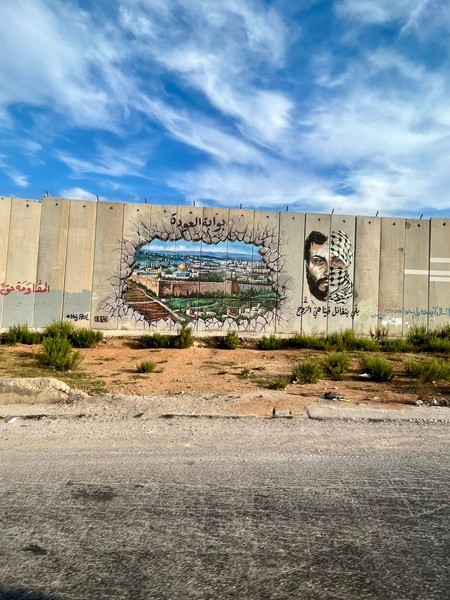 The wall between Lebanon and Israel.
The wall between Lebanon and Israel.
At eight o'clock we leave our hotel and drive towards the monument in Tyre for the fallen soldiers in the service of Unifil. After wreath laying and tribute we go to the old part of the city of Tyre.
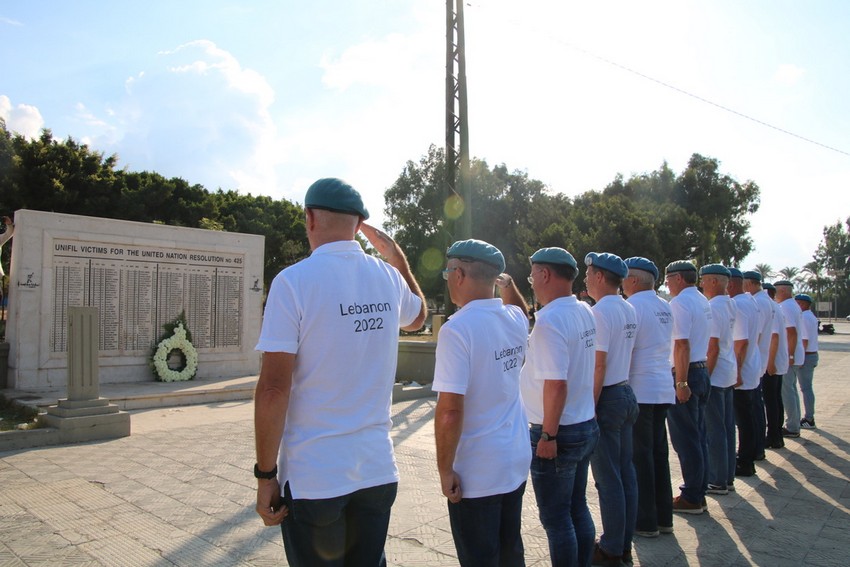
Tribute to those killed in the service of the United Nations.
In this ancient part of the city we see an unprecedented collection of history dating back more than 2000 years ago. We walk on a cobbled road in the Necropolis, the ancient cemetery of Tyre, with sarcophagi on both sides and houses where relatives could be buried together.
One sarcophagus has a block-shaped protrusion at the headboard with a channel in it. The deceased, a wealthy wine merchant named Cerano, was given wine through that channel by his friends when they all came by to drink a glass.
Next to Necropolis is the Hippodrome where the locals could enjoy horse racing 2000 years ago. Some of the stands are still accessible.
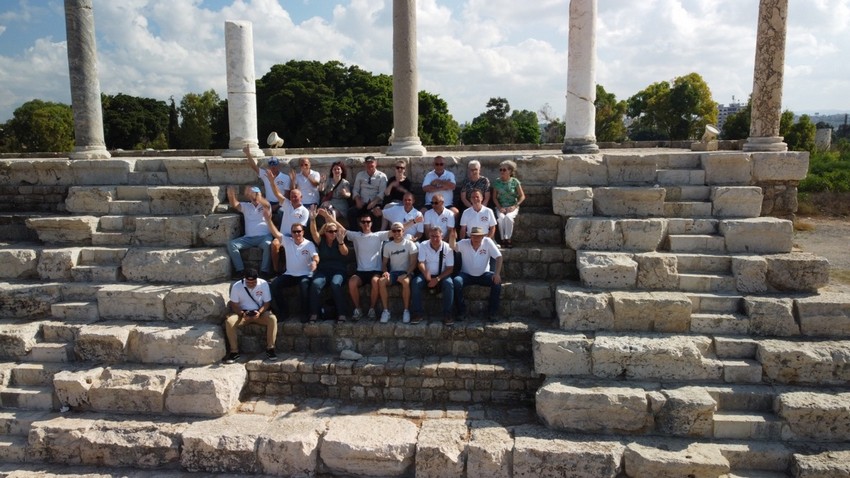 Grandstand at Hippodrome in Tyre.
Grandstand at Hippodrome in Tyre.
In these historical places it is visible how rich and inventive Roman society was.
Water supply via aqueducts, cobbled roads surrounded by marble pillars and in the inner city even more wealth such as a large Roman bathhouse with underfloor heating and beautiful mosaics on the floor.
After visiting the Roman excavations we walk through the Christian quarter of Tyre. This is the last part of our visit to Southern Lebanon and we travel via Sidon towards Beirut.
In Sidon we visit the crusader castle on the harbor, the souk and we have lunch in a restaurant overlooking the harbor.
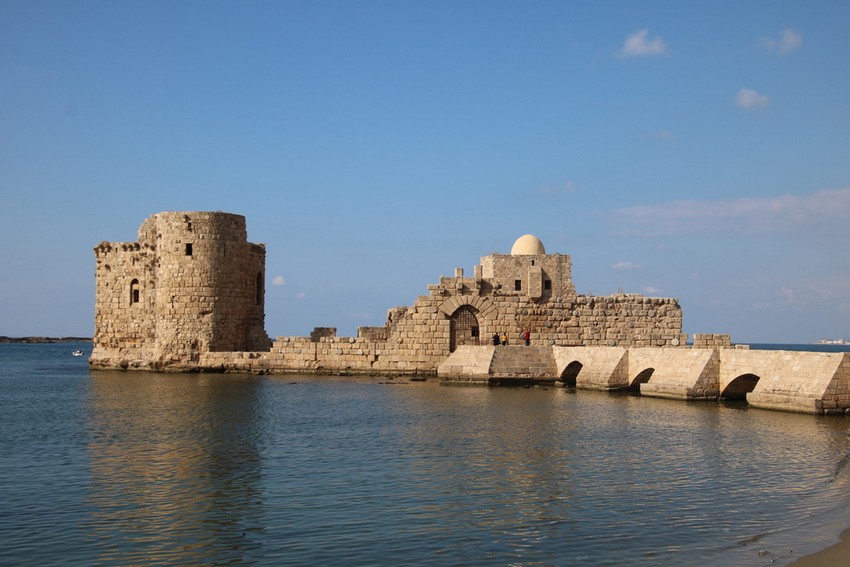 Crusader castle in the port of Sidon
Crusader castle in the port of Sidon
After the visit to Sidon we leave for hotel Le Commodore in the Hamra district, the center of Beirut. Marty and I are interviewed for the last time by Teun and Marcus and join the dinner.
During dinner, the last 11 hours are for Maaike and Hessel, respectively daughter of Ton and son of Yeb-Jan. Both thought it was a special trip and were impressed by the frankness and mutual support with which we dealt with each other. Maaike has the feeling that this trip has given her a stronger bond with her father. For Hessel it was a very beautiful and impressive journey. He thought it was special to be able to share this journey with his father and us. Because everyone was more and more open and shared beautiful and also less beautiful stories, he has gained a better understanding of what we and his father have all experienced.
After dinner we go into the nightlife of Beirut.
Day 8, Friday 14 October
After breakfast at 8 o'clock we leave the hotel. The first short photo opportunity is at Raouch or the pigeon rocks, two rocks close to the coast near Beirut.
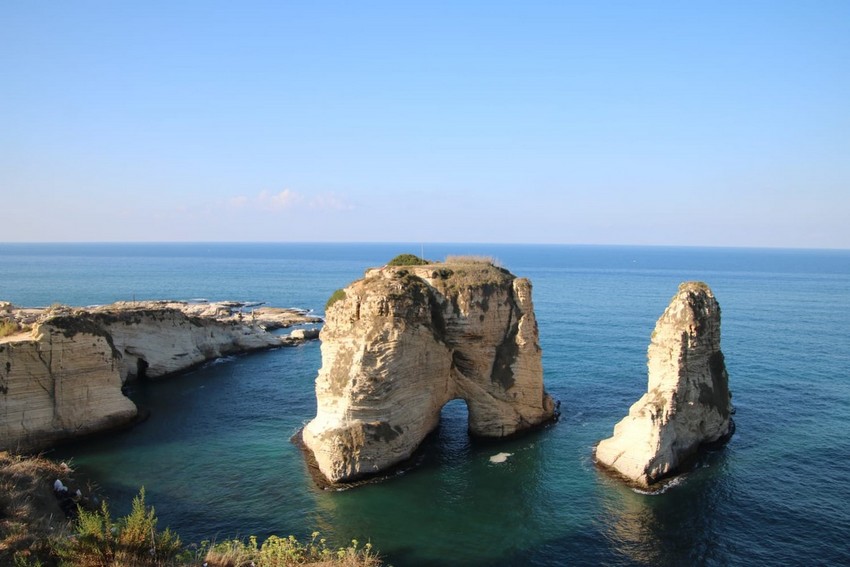
Pigeon rocks at Beirut
We continue on the Corniche, beirut's coastal promenade and take an exit into the mountains to area of the Druze. This is a beautiful area with lots of greenery and pleasant climate because it is located at an altitude of about 800 meters.
Our goal is Beit Ed-dine, the palace of Beshir II, built in the 19th century. From George we get an explanation about the architecture and the history of the building.
The palace is built in oriental style but also has Italian and traditional Lebanese influences. It is a beautiful luxury finished building with many spaces for receiving guests.
The luxurious Hamman or Turkish bath is richly decorated and has a beautiful natural light that enters through the domes. The sanitary facilities are high quality for that time.
After visiting the palace we head towards the nearby village of Deir el Qamar. After visiting some souvenir shops we will have lunch.
During lunch we have animated conversations about which mint is the tastiest.
After lunch we leave for Beirut to the former green line. There, during the civil war, the most important battles were between Muslims and Christians.
After the peace, this area was fully restored and a large mosque and a large church were built next to each other. We visit both places of worship. In the mosque, the women are only allowed to enter with covering clothing.
The last 1.5 hours is at leisure in downtown Beirut in Hamrahstreet and then we get on the bus to the airport where we arrive at 6 pm.
At 20:30 our plane leaves for the Netherlands. Arrival at Schiphol at 00:15.
Our fantastic journey has come to an end, for which thanks to the organizers Bert and Jeannet.
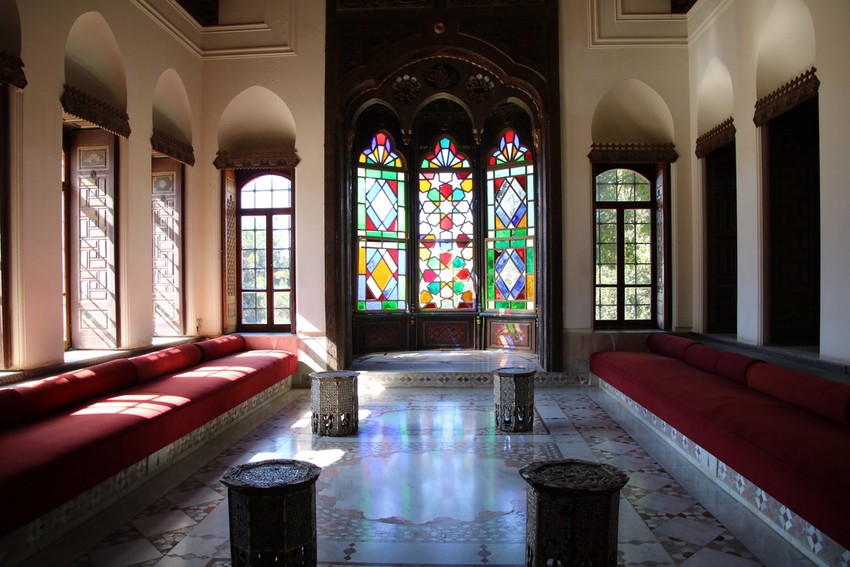
Beit Ed-Dine Palace
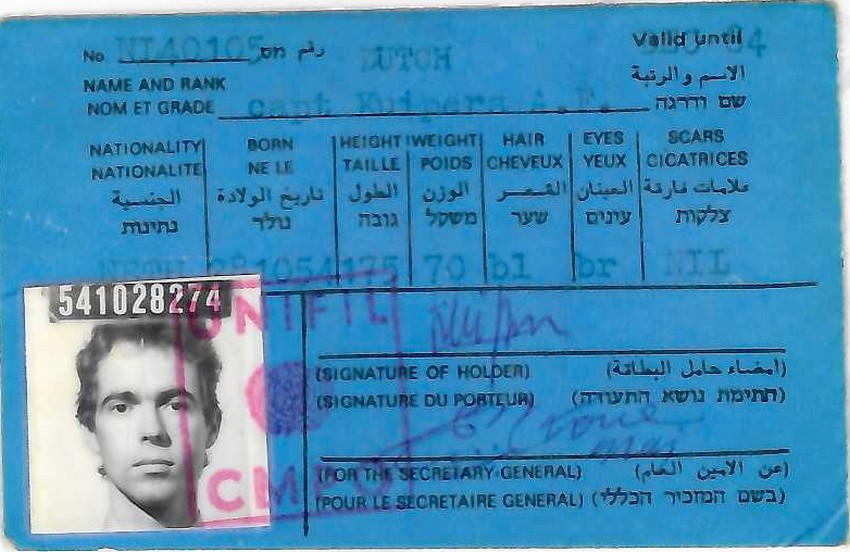
Thanks to everyone, especially Wim for his great photos, Yeb-Jan, Maaike and Hessel for their contribution.
Bart Kuipers.









